Trends & Insights From Asset Management Software Buyers in 2022
Despite the disruption caused by the COVID-19 pandemic and the uncertainty organisations from every industry continue to face, Comparesoft continues to work closely with its partners and match Asset Management Software (AMS) buyers with solutions tailored to their needs.
As a result of these activities, we have analysed buyer requirements, industries and roles. We’ve also examined market trends and opportunities. Here’s a summary of what we’ve found.
AMS User Requirements
- The average buyer uses spreadsheets to manage assets valued up to £1 million and connected to people, projects, locations and/or equipment. They’re looking for a two-to-ten user system that they can start implementing in under three months. They manage a combination of equipment, IT hardware and facilities, and require an asset register, asset tracking capabilities, support for maintenance management, and inventory management features.
AMS User Industries and Roles
- The industry, role and seniority of an average buyer is difficult to determine. They’re slightly more likely to occupy a senior, executive or leadership role than they are a mid-tier/management or field, operations and administrative role. There’s a slight bias towards IT-focused roles, and outside of education, there are no particularly common industries. The only commonality amongst Asset Management Software buyers is the diversity of their industries, roles, and seniority.
AMS Market Trends
- We see two complementary trends. First, the transition to “next-generation” organisations; organisations that emphasise principle-driven, autonomous decision-making and remote-first, hybrid-working within empowered, distributed teams. Second, is the determination of individuals to keep using spreadsheets.
Gaps In the Asset Management Market
- We see five opportunities in the AMS Software market. Chief of these is the chance to design, test and deliver “advanced” asset management functionality to organisations and industries for whom it was recently unaffordable and/or inaccessible.
The summaries are a result of on-platform data analysis, off-platform research and investigation, Comparesoft’s understanding of AMS Software, close partnerships with our vendors, and interactions with buyers. Read on to explore each of the sections in more detail.
FREE DOWNLOAD: AMS Market Report and Insights Infographic
User Requirements
Summary: The average Asset Management Software buyer is using spreadsheets to manage assets that are valued up to £1 million and connected to people, projects, locations and/or equipment. They’re looking for a two-to-ten user system that they can start implementing in under three months. They manage a combination of equipment, IT hardware and facilities, and require an asset register, asset tracking capabilities, support for maintenance management and inventory management features.
Asset Types
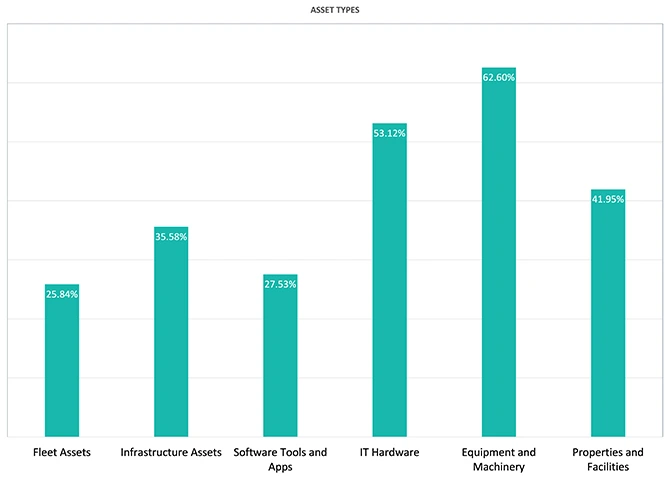
- The average user manages at least two different asset types.
- The most common asset type was equipment and machinery (~62%).
- IT hardware (~53%) and properties and facilities (~42%) were also popular.
- The least popular asset type under management was fleet assets (~26%).
- ~24% of users manage both IT hardware and IT software.
- ~19% of users manage properties, equipment and infrastructure.
- ~11% of users manage all asset types—properties, equipment, IT hardware, infrastructure and fleet—except IT software and applications.
Features
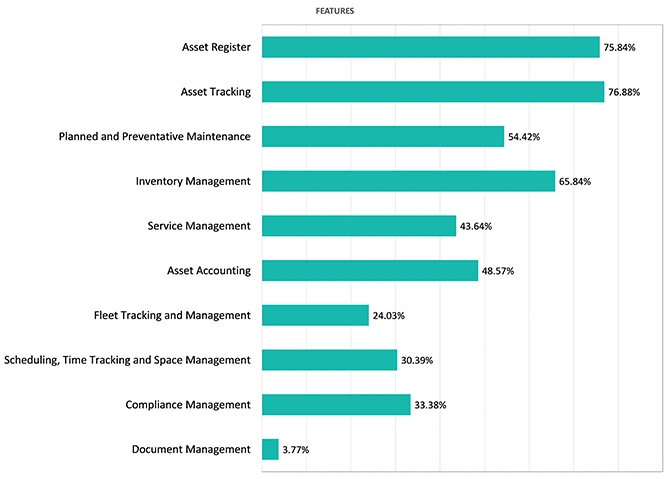
- The average user cites at least four required features for their AMS solution.
- An asset register and asset tracking were the most popular features (~76% and ~77%, respectively).
- Inventory management (~66%) and planned and preventive maintenance (~55%) were also commonly required.
- The least required feature by far was document management (~4%), with fleet tracking and management (~24%) also appearing unpopular.
- ~18% of users required asset-focused features: an asset register and tracking, maintenance management, asset accounting and compliance.
- ~27% of users required features for managing planned and preventative maintenance, service delivery and inventory.
- ~9% of users required all listed features—from asset tracking to fleet management—apart from document management.
Asset Relationships

- ~69% of users reported that their assets were connected to people, locations, projects and/or equipment.
- ~46% of users said their assets were standalone and managed independently, whilst ~36% reported that their assets were connected to people only.
Existing Systems
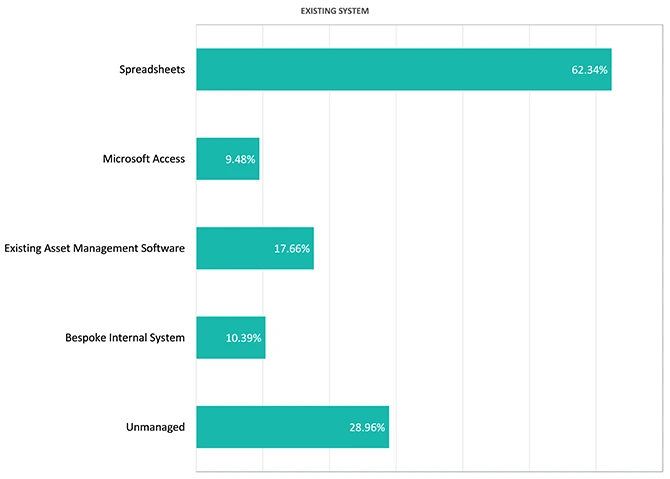
- ~62% of users use spreadsheets to manage their assets.
- The next most cited asset management methods were no method at all (~29%) and an existing solution (~18%).
- Microsoft Access (~9%) and bespoke internal systems (~10%) were the least popular asset management methods.
- ~13% of users utilise spreadsheets alongside Microsoft Access, an existing AMS solution or a bespoke internal system for asset management.
Asset Value
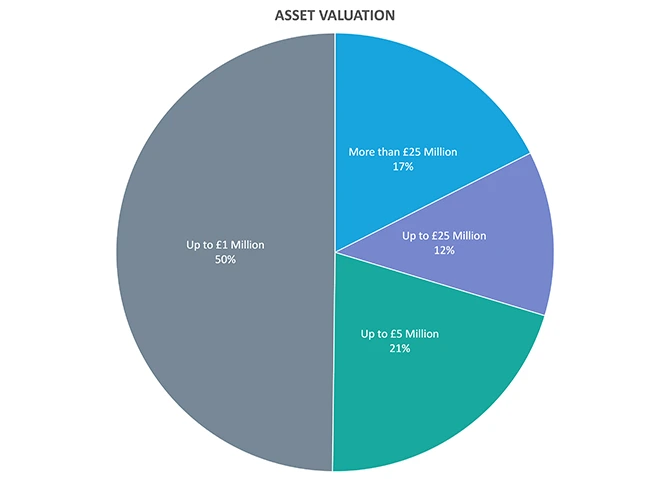
- ~49% of users are managing assets with a value of less than £1 million.
- Asset valuations of up to £5 million (~21%) and over £25 million (~18%) were the next most popular.
- The least popular asset valuation was up to £25 million (~12%).
- Overall, ~83% of users are managing assets with a value under £25 million.
User Volume
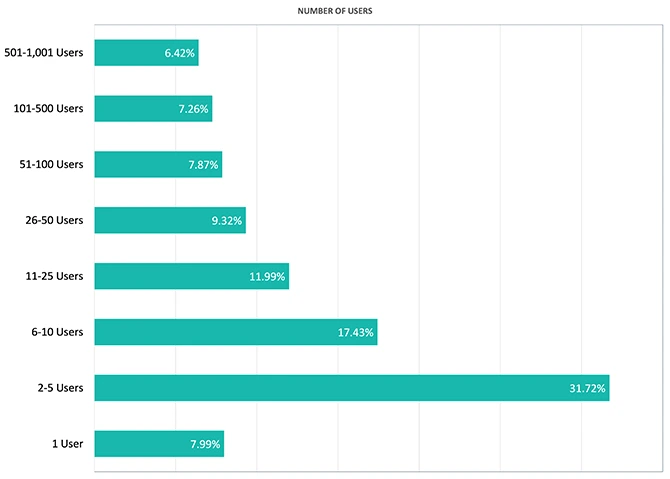
- The most popular user count was 2-5 users (~32%).
- User counts of 6-10 (~18%) and 11-25 (~12%) were also popular.
- The least popular required user counts were 1 user (~8%) and 501-1,000 users (~6%).
- ~69% of users required an asset management solution that supports 1-25 users, with ~31% requiring a system that supports over 25 users.
Implementation Timescale
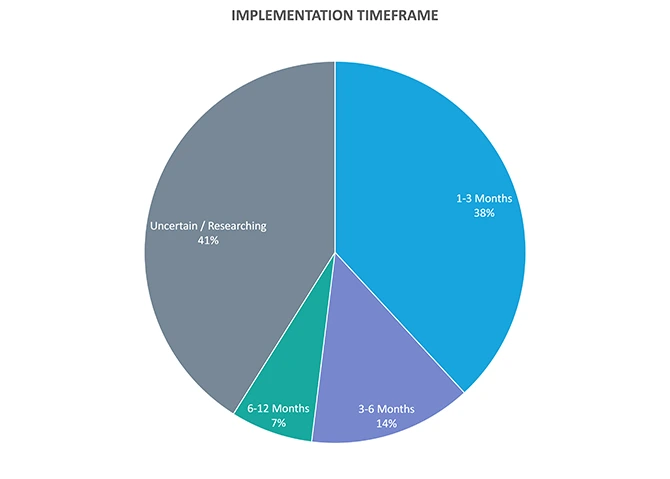
- The majority of users (~41%) reported that they were uncertain of their implementation timescale or were just researching their options.
- The most cited implementation timescale was 1-3 months (~38%).
- An implementation timescale of 3-6 months was cited by ~14% of users, whilst a timescale of 6-12 months was cited by ~7% of users.
- Overall, ~79% of users were either uncertain about their options or were looking to start implementing a solution in 1-3 months.
*Please note: the analysis in items one, two, and four are based on additional data analysis beyond the included graphic.
User Industries and Roles
Summary: The industry, role and seniority of an average Asset Management Software buyer is difficult to determine. They’re slightly more likely to occupy a senior, executive or leadership role (~36%) than they are a mid-tier/management or field, operations and administrative role (~32%, respectively). There’s a slight bias towards IT-focused roles (~18%), and outside of education (~14%), there are no particularly common industries. The only commonality amongst Asset Management Software buyers is the diversity of their industries, roles, and seniority.
Industry Distribution
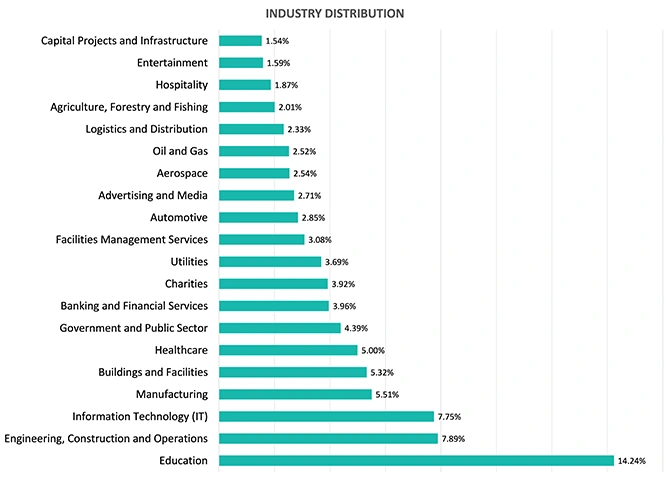
- The most cited industry was education (~14%).
- The next most popular industries were engineering, construction and operations (~8%) and information technology (~8%).
- Manufacturing, buildings and facilities, and healthcare were also common, appearing approximately ~5% of the time, respectively.
- Overall, the top 20 industries accounted for ~85% of users, with the remaining ~15% distributed amongst at least thirty other industries.
Role Distribution
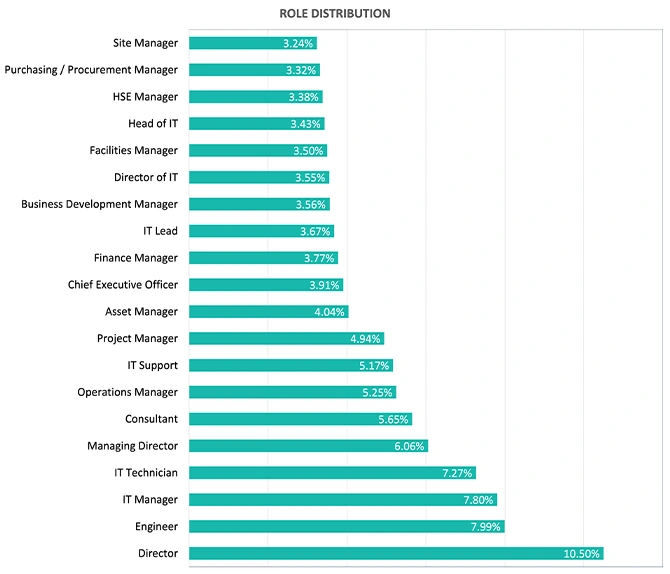
- “Director” was the most popular title (~5%).
- Variants of “Director” (including “Managing Director” and “Director of IT”) occurred in ~10% of cases.
- “IT Manager” and “IT Technician” were also common roles, appearing ~4% each.
- Roles associated with IT were the most dominant group, with titles like “IT Lead”, “IT Manager”, “Head of IT” and “IT Support” making up six of the 20 most cited roles, and ~18% of all roles cited.
- “Engineer” (~4%) was the second most frequent, with representation from other operations-focused roles, such as “Operations Manager” and “Project Manager” common.
- Variants of “Consultant” were surprisingly frequent, occurring ~3% of the time and coming in as the seventh most common title.
- The top 20 titles accounted for ~48% of all users.
Seniority Distribution
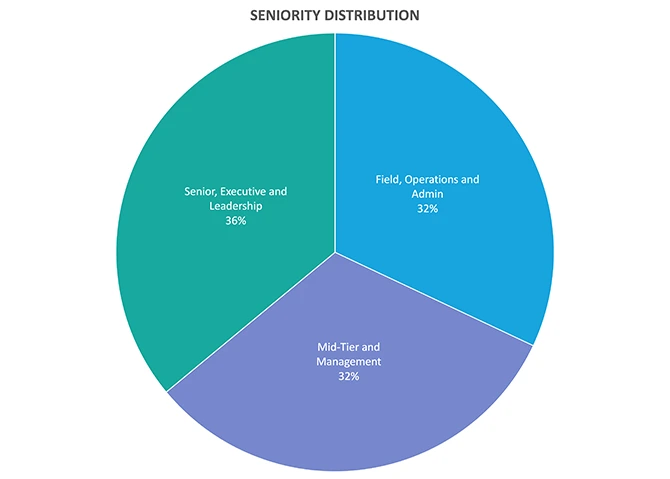
- ~32% of users occupy field, operation, or administrative roles.
- ~36% of users occupy senior, executive or leadership roles.
- ~32% occupy mid-tier or management roles.
- Overall, the seniority of Asset Management Software buyers was almost evenly distributed.
AMS Market Trends
Comparesoft has identified two significant trends that will impact asset management organisations. The first is the continued transition to remote-first, autonomous teams and ways of working. The second is the continued survival of the simple spreadsheet.
The Transition to “Next-Generation” Asset Management
On Industrialisation is an in-depth research program conducted by Simon Wardley, a researcher and consultant. It explores key differences between “traditional” and “next-generation” organisations. The program covers multiple areas, including approaches to sustainability, technology, structure, orchestration and learning. However, underlying the differences across these areas is an even more fundamental difference:
- “Traditional” organisations cling to office-first, procedure-driven approaches managed via hierarchical structures, centralised locations and scarce expertise
- “Next-gen” organisations emphasise principle-driven, autonomous decision-making and remote-first, hybrid-working within empowered, distributed teams
The consequence of being a “next-gen” organisation or a “traditional” organisation rapidly reveals itself in the domain of asset management. To see how, we’ll consider an example of basic asset management (locating an asset and updating its status), as well as a more advanced asset management scenario (making a repair-replace decision for a mission-critical asset). Specifically, we’ll see two scenarios involving a bronchoscope used in a hospital clinic:
Scenario #1A: A “traditional” organisation locates an asset and updates its status
A team member is exiting a meeting and heading to another. They are responsible for the department’s share of the organisation’s asset management system. They are seen by their manager and asked to perform the already overdue annual inspections for the department’s clinic assets. The team member consents, hustles to their planned meeting, and returns to their desk shortly after.
They open the asset management system and use a query to find the clinic assets in need of inspection and update. They make a note of each asset in their notebook—as well as the information that needs to be captured. The schedule indicates that no clinics are in progress. They head out to the clinic room.
They arrive at the clinic room and find an urgent, unplanned clinic has just begun. They depart, returning several hours later once the clinic is finished. Upon their return, they find that one asset—a bronchoscope—is absent. The team member heads to the office of the clinic lead and is informed that the bronchoscope was unofficially “loaned out” for the day to ensure a clinic elsewhere in the hospital could go ahead. The team member departs with a promise that the asset will be returned to the department by the end of the day; it was a temporary loan.
The next day, the team member returns to the clinic room to inspect the asset. Finding it still absent, the team member goes over to the room housing the alternative clinic, confirms the asset is no longer needed, and brings it back.
The team member performs the inspection, captures the necessary information, and returns to their desk. The information is transcribed from their notepad into the asset management system. The inspection procedures are signed-off. The date counter for the asset inspections are manually reset. Finally, the team member sets themselves a reminder several days ahead of the planned inspection time, to ensure the next one doesn’t get missed.
Scenario #1B: A “next-gen” organisation locates an asset and updates its status
The team member responsible for the department’s asset management system receives an automated email. They are informed of multiple assets which have entered the week-long inspection window.
They log on to the asset management system, viewing the summary of the required inspections and the estimated time required to complete them. The team member uses the integrated scheduling function to select one of the suggested times for inspection. They select an afternoon slot on the same day. The affected assets are automatically reserved for that period and a block is reserved in the team member’s calendar.
Around lunchtime, an urgent clinic involving multiple assets due for inspection is scheduled. The team member receives an automatic notification and reschedules the planned inspection for the following morning.
First thing the next morning, the team member departs for the inspections. Using a tablet device, they start the tailored inspection rounds, logging different information types for the different assets and uploading photos as they go.
Towards the end of the inspection, a change to the status of a still-to-be-inspected asset—a bronchoscope—is requested. The attached note informs the team member that the scope is needed for another urgent clinic happening later in the day.
The team member heads straight to the nearby clinic room housing the asset, speaks to the person requesting the change, and quickly performs the required inspection before approving the asset update.
The team member proceeds to complete the inspection of the remaining assets. Updates to inspection date counters are automatically triggered, inspection digest emails are distributed to key stakeholders, and any required work orders are created and sent to the relevant parties.
Scenario #2A: A “traditional” organisation makes a repair-replace decision
Yet another bronchoscope issue—the third in as many weeks—prolongs a regular clinic, pushing back other scheduled appointments, keeping numerous team members in attendance for longer than planned, and degrading the service experience for a patient.
After the session, a frustrated clinic attendee approaches the head of department and queries about the increased rate of bronchoscope issues in recent weeks. The team member is thanked for the feedback and told it will be actioned.
Three weeks later—and after a hastily purchased scope component had to be couriered in—the clinic attendee raises the issue once more.
They are thanked for following up. They are told that because it is approaching the end of the financial year there is no room for a new scope. Additionally, the existing scope is old and no longer stocked; there is no time to explore, evaluate, trial and verify a new scope right now.
The clinic attendee recommends purchasing a new scope. The existing asset is becoming increasingly disruptive to service delivery and it is increasingly expensive to source parts. The head of department agrees but says their hands are tied. They suggest a compromise: they will purchase excess component parts in the hope that they sustain the clinic until the new budget rolls around. Once it does, the department head can “make room” for the new scope purchase.
The clinic attendee reluctantly agrees but continues to periodically advocate for a new scope. An alternative scope purchase is signed off by the department head several months later—and after a few more unexpected issues—once the existing scope has proved unfeasible to continue using within existing services.
Scenario #2B: A “next-gen” organisation makes a repair-replace decision
For the third week in a row, a bronchoscope issue slows down the delivery of a clinic. A clinic attendee suspects a chronic issue and flags the asset for investigation.
The next day, the department’s asset manager reviews the flagged items which include the bronchoscope. They look at the asset record of the flagged scope and compare it to baselines of similar scopes used elsewhere. Usage volume, purchase date, value and depreciation, issue volumes, and issue types are all considered.
The asset manager notices that bronchoscope issues are increasing in other departments, too, and rules out an isolated, independent defect. After checking clinic attendee training records, damage from improper use and storage is also deemed unlikely—though a note is distributed to raise awareness of the issue and ensure adherence to proper practices.
The asset manager suspects that the increase in issues is due to an increase in scope usage. After checking the scheduled clinics in recent weeks and months, a significant increase in bronchoscope usage across departments is noticed.
The asset manager quickly compiles a report containing the actual and projected impact of continued bronchoscope issues. It includes the effects on SLAs and patient experience, as well as financial costs of replacement parts and lost clinic time. The asset manager also compiles an assessment of the impact of purchasing additional bronchoscopes—in one scenario, purchasing sufficient scopes to match the expanded schedule, and another, preemptively acquiring additional scopes to mitigate further increases in clinic delivery and scope usage.
The asset manager’s purchase cap allows them to generate and approve a PO for a single replacement bronchoscope. This accomplished, the asset manager forwards their full investigation—including a summary, reports and links to all relevant asset records—to their head of department with the recommendation that their own and other departments coordinate to invest in a minimum of extra capacity to handle the additional clinics.
* * *
The above examples reveal the difference between how “next-gen” and “traditional” organisations operate both strategically, operationally and minute-to-minute.
“Next-gen” organisations willingly distribute autonomy to their teams, support personnel and management staff. They provide individuals, teams and departments with options and give them the tools to make intelligent, contextualised, end-user-driven choices. Reporting, analysis, decision-making, and adaptation are open, participatory processes instead of opaque, inaccessible, need-to-know procedures.
Why this occurs is straightforward. “Next-gen” organisations are more effective and more efficient across every dimension, from employee satisfaction to financials and customer experience. The how is slightly trickier.
“Next-gen” asset management approaches require a certain type of asset management solution. One that supports principle-driven, autonomous decision-making and remote-first, hybrid-working within empowered, distributed teams. Fortunately, these solutions are already available and becoming more accessible to everybody. But what do they have in common? Here’re four possibilities:
1. Make the manual digital and the digital automated
- Time-consuming manual processes, such as updating an asset’s location or assignee, are converted to digital equivalents. Where possible, these digital equivalents are then automated, putting the burden of both basic and advanced asset management onto machines. This frees people up and enables them to focus on high-value, high-leverage work.
2. Provide right-sized solution access and capabilities
- Data visibility and product functionality access are configured to match the changing reality of day-to-day operations. The implementation of security schemas and critical process controls for different user types are based on observed and required behaviour, instead of idealised models. More importantly, data visibility and product functionality access controls are designed to be updated and adapted according to an organisation’s needs.
3. Remove friction from core processes
- Something that gets done every day shouldn’t be hard, confusing and complicated. Core processes—whatever they are for the organisation in question—should be easy to adopt, simple to maintain, quick to evaluate, and ready for experimentation and adaptation.
4. Enable self-service for complex processes
- Not every use-case can be predicted or standardised in advance. Some scenarios are too complex. To tackle these, it’s best to provide users with the tools they need to succeed and do it in a way that requires minimal input or approval from another source. That could be the ability to query data and generate a targeted report. It could be the ability to push or pull information from a third-party tool, app or system. Or it could be the ability to mention a colleague’s name in a comment or allocate multiple owners of an asset.
The number of “next-gen” organisations—organisations that focus on principle-driven, autonomous decision-making and remote-first, hybrid-working within empowered, distributed teams—is increasing. And they require systems that digitise and automate routine work, provide right-sized access and functionality, minimise the friction in core processes, and include flexible self-service tools.
With the appropriate solution, “next-gen” organisations can maximise the value delivered to their customers whilst saving money, saving time, saving effort, improving communication, fostering collaboration, and minimising stress. They can become even more efficient and even more effective than their “traditional” counterparts.
Individuals Like Spreadsheets
The digital spreadsheet is almost as old as personal, general-purpose computers. One of the first popular applications, VisiCalc, was released in 1979. Data represented in a tabular format is even older, with a history that spans centuries. The spreadsheet is not a modern innovation, so it’s no surprise that current applications—Microsoft Excel, Google Sheets, LibreOffice Calc, Zoho Sheet, Apple Numbers—are seen as too simple and archaic for today’s asset management.
Like many other disciplines, contemporary asset management is gaining in complexity and showing no signs of slowing down. It involves numerous stakeholders, competing priorities, changing cultural expectations, and adherence to evolving processes that operate at different scales and tempos. Even in its basic format, asset management is surprisingly complex. Consider these fundamental questions which are often asked of every asset:
- What is it?
- Where is it?
- How valuable is it?
- Is it okay?
These questions are the essence of asset management, and maintaining the answers involves a lot of time, energy and expertise. But modern asset management can be far more complex. A comprehensive asset register could include:
- Basic information (e.g. IDs, descriptions, serial numbers)
- Asset statuses
- Locations and sub-locations
- Asset assignees and owners
- Asset categories, groupings, types and sub-types
- Parent-child relationships (e.g. associated parts, product trees)
- Relevant health, safety and compliance information
- Lifecycle information (e.g. remaining useful life)
- Financial information (e.g. purchase values, depreciation, linked costs)
- Contractual information (e.g. SLA benchmarks, warranties, service entitlements)
- Maintenance information (e.g. historical work orders, planned work)
- Audit, inspection and survey data
- Attached documentation and images
- Access to historical asset data
- Access to real-time condition/IoT sensor data
- User comments and notes
And this is only the beginning. Asset management is not confined to individual assets. It involves dynamic connections to:
- Other assets, stock and inventory
- Individuals, teams, departments, organisations and customers
- Properties, sites, locations and mobile stores
- Large projects and small tasks
The average organisation has numerous assets under management—anywhere from hundreds to tens of thousands. Managing all these assets’ information, actions, and connections over time is a serious undertaking. Yet despite the scope and the challenges, spreadsheets are still ubiquitous.
We encounter spreadsheets in our research and in our interactions with AMS Software buyers. When they’re not the sole tool in use—which happens more regularly than one might think—spreadsheets are often used in parallel to existing or bespoke asset management solutions. And they’re used for both basic and advanced forms of asset management; from one-man SMEs to globe-spanning enterprise organisations.
This phenomenon isn’t unique to asset management, either. Maintenance managers and leaders cite the use of spreadsheets in their core operations. Even in the high-flying world of finance, the humble spreadsheet forms the foundation for many pivotal analyses and key decisions. Why is this? Why does the spreadsheet persist? Here are some possibilities:
- Spreadsheets are a generic, self-service data analysis and visualisation tool
- Spreadsheets allow non-technical users to manipulate their data with ease
- They come with a large, established library of accessible methods
- Their methods can be chained together to form complex pipelines
- Spreadsheet users have a multi-decade base of support to draw on
- They’re familiar and comfortable to users, instead of shiny and scary
- Spreadsheets can be hacked and extended by technical users
- Spreadsheets have hundreds of little-known features for almost any use case
- They’re easy to share and encourage collaboration between individuals, teams, departments and organisations
- Spreadsheets are no match for powerful data tools, yet they are often used as a “sanity check” on their outputs
- Spreadsheet competency is a valuable, marketable skill that organisations understand and users can immediately leverage in new environments
As the list above makes clear, spreadsheets serve individuals. Unfortunately, this contradicts what most organisations perceive as the best way to manage assets and the best way to tackle continual increases in complexity.
Organisations are trying to move away from general purpose, individual-focused tools such as spreadsheets. In their place, they’d like to see whole, connected systems. This is why phrases such as “consolidated”, “end-to-end” and “integrated” are used. Both organisations and AMS Software vendors think there is a better, more reliable way to capture, clean, distribute and leverage data. One that minimises leakages, lightens the IT administrative burden, and facilitates decision making.
However, these organisations are composed of individuals that prefer to use something simple that works instead of something complicated that may not. These individuals see the edge cases and the grey zones that get blurred out when solution requirements are compiled and systems are architected.
The mismatch between organisations seeking systemic solutions and individuals favouring simple, known tools is predictable. Solutions that support imports and exports via common formats, and reproduce the accessibility and flexibility of spreadsheets will see greater adoption. Solutions that don’t, won’t.
The world is increasing in complexity. Organisations are responding by deploying their own increasingly complex asset management systems. Individuals, on the other hand, are doubling down on simpler tools, such as spreadsheets.
This is natural. At the organisational level, complex requirements often necessitate complex solutions. Individuals are different. Day in, day out, they prefer simplicity. They like their spreadsheets. And they’ll do a lot to keep them.
Complementary Responses to Complexity
Organisations are responding to the increasing complexity all around them by changing themselves. They are becoming principle-driven, encouraging autonomous decision-making, and deploying remote-first, empowered teams.
At the same time, the individuals within these teams, departments and organisations are betting on simplicity. They’re adopting the consolidated, end-to-end, dedicated systems that are required of them whilst continuing to navigate much of their work using the tried-and-tested spreadsheet.
These two responses may seem contradictory but the desired outcome of both is the same: the effective handling of increasing complexity. These two trends are set to gather more momentum, and represent significant opportunities for asset management solution providers, as well as organisations considering their own approach to asset management.
Gaps In the Asset Management Market
The fundamentals of asset management haven’t changed much in recent years. Unlike adjacent disciplines—such as facilities management, maintenance management or field services—the core of asset management has remained intact, despite worldwide turmoil and disruption. The individuals, teams, departments and organisations involved with asset management are still trying to do the same things, and still trying to do them better. There are significant opportunities for Asset Management Software vendors that recognise this.
This section of our AMS reports explores what Comparesoft believes those opportunities to be. But before we examine them, it’s worth considering the largest and most significant opportunity of all. It is a consequence of this fact:
- The cost of effective asset management is dramatically decreasing
Organisations today have access to off-the-shelf and customisable equivalents of what, five years ago, would have cost a global enterprise organisation six figures and a year of implementation. Asset management functionality that was considered “advanced” or “state of the art” then is commonplace and implicitly expected now. This is the march of technological development and diffusion, except faster. And it’s the critical opportunity:
- To design, test and deliver “advanced” asset management functionality to organisations and industries for whom it was recently unaffordable and/or inaccessible
This observation—and the opportunity it represents—underpins the four other opportunities that Comparesoft has identified in the Asset Management Software market:
- The digitisation of asset management
- Remote asset monitoring and inspection
- Bringing assets online
- Increasing asset uptime
Let’s look at each of these in turn.
1. Digitising the Spine
Digitisation across different industries isn’t a revolution. It’s a known trend that has been occurring for several decades. Within asset management, however, it has a particular flavour.
Until recently, a surprising number of individuals, teams and departments—sometimes, whole organisations—managed their core processes using not much more than spreadsheets. That includes everything from an SME keeping a spreadsheet of assets in a room to an enterprise operation maintaining carefully constructed, interlinked maintenance spreadsheets.
Such approaches were commonplace, and dedicated solutions—either a limited use, optimised tool or a consolidated end-to-end system—were the minority. This has flipped. As described above, spreadsheets are here to stay: individuals like them. But the complexity involved in modern asset management quickly reveals spreadsheets to be a tool too complicated, fragile and unreliable for large-scale asset management.
Organisations performing basic asset management—asking questions like, “What is this asset?”, “Where is it?”, “How valuable is it?” and “Is it okay?”—are quickly bypassing spreadsheets. They wouldn’t have a year or two ago.
Organisations undertaking more advanced asset management—managing lifecycles, maintenance, documentation, real-time health and performance data, compliance requirements? They don’t even consider spreadsheets as an option anymore. They know the complexity of their operations and understand that they need a dedicated solution in order to tackle it effectively and sustainably.
The digitisation of asset management isn’t about the move from pen and paper to spreadsheets (although that is still a key change in many organisations). It’s about strengthening asset management processes with a dedicated digital solution that can be relied on to do the job. Often, the first step on that journey concerns the spine of asset management: the digitisation of the asset register.
2. Driven by Technology, Not Humans
“Asset monitoring and inspection” conjures images of clipboard-wielding individuals poking and prodding a piece of equipment and hastily scribbling down their observations. In asset-intensive industries—electricity, utilities, infrastructure, oil and gas, aerospace—that’s no longer the reality.
Human-driven monitoring and inspection has become too risky, too slow, too unreliable and too expensive. Instead, technology-driven approaches to monitoring and inspection are the norm in asset-intensive industries. These include:
- Drone-led visual inspections of difficult-to-access areas
- VR-driven facility, equipment and infrastructure management
- AR-assisted issue investigation and diagnostics
- Alternative inspection techniques (e.g. ultrasonic testing)
The uptake of technology-driven remote monitoring and inspection approaches is continuing to accelerate in asset-intensive industries. More importantly, it is an approach that is starting to see adoption and traction in non-asset-intensive industries as well. For example:
- A domestic roofing service provider can use a low-cost drone to perform an initial roof inspection and provide an accurate quote to a customer
- A facility manager can use an interactive 3D BIM model of their building to manage assets, work orders, occupancy rates and room bookings
- A junior field service engineer can live stream their first investigation of a new equipment type, receiving guidance from a veteran engineer operating elsewhere
- A QA manager at a tube manufacturer can use a handheld acoustic pulse device to detect flaws and defects, instead of relying on their own eyesight or slower, cumbersome testing techniques
These are example scenarios that represent significant opportunities. The majority of organisations are not operating in asset-intensive industries and don’t have large CapEx and OpEx budgets to implement cutting-edge asset monitoring and inspection approaches. Fortunately, these approaches are becoming increasingly accessible whilst the benefits they offer remain disproportionately large.
3. Bringing Assets Online
It’s not just remote asset monitoring and inspection approaches that are becoming more affordable and accessible; more and more assets are now coming online.
Automated monitoring and control systems have been around for a while in industries such as automotive, manufacturing and food and beverages. Programmable logic controllers (PLC), distributed control systems (DCS) and supervisory control and data acquisition (SCADA) systems are well-known in these areas; IoT-driven processes that generate real-time data and leverage parameter and event-driven actions are increasingly common to such industries.
Now, these approaches are seeing adoption in all industries. Not just those that are asset-intensive or renowned for their stringent compliance requirements. IoT-driven processes in particular are experiencing a rapid increase in demand. There are several reasons for this:
- Falling per unit costs
- Increasing ability to purchase small batches and individual units
- Growing resilience, lifespan and reliability of the units themselves
- A move towards open standards/interoperability of generated data
- Increasing availability of multi-modal units (e.g. one unit for multiple data types)
- Configuration, adaptation and analysis workflows designed for non-technical users
- The capacity for fast, small-scale implementations that require minimal organisation-level coordination and IT integrations
It’s now feasible for a facility manager to kick-off a one-site pilot of an IoT-driven, usage-based maintenance management program. An engineer can independently attach multi-modal sensors to a business-critical piece of plant machinery and start correlating vibration data and temperature with machine downtime. An asset manager can—whilst working remotely and accessing real-time data—perform in-depth analyses, receive automated outlier notification and disruption predictions, and make informed decisions. This isn’t possible when assets are offline and unconnected.
4. Reliable, Sustainable Value Delivery
The fourth opportunity is linked to the previous three:
- The digitisation of asset management
- Remote asset monitoring and inspection
- Bringing assets online
The biggest benefit of digitising core asset management processes, leveraging previously “advanced” monitoring and inspection approaches, and bringing assets online is the gain to asset uptime. Simply put: assets that are digitised, networked and remotely monitored will see greater health and performance over their lifespan.
This increase of asset uptime is what organisations are really interested in. Not because uptime itself is valuable but because asset uptime is a key enabler of an organisation’s ability to reliably and sustainably provide value to new and existing customers.
Five Opportunities
Above, we’ve considered four opportunities in the Asset Management Software market. These four — the digitisation of asset management, remote asset monitoring and inspection, bringing assets online, and increasing asset uptime — are significant and form the foundation for the fifth, the largest opportunity:
- To design, test and deliver “advanced” asset management functionality to organisations and industries for whom it was recently unaffordable and/or inaccessible
The Modern Asset Management Game
Modern asset management is, at its core, still concerned with fundamental questions. It is about visualising assets, maximising their uptime, and leveraging them to deliver value to end users and customers. So what makes modern asset management different, then?
In this report, we have looked at:
- AMS user requirements
- AMS user industries and roles
- AMS market trends
- AMS gaps in the market
Each of these sections, in its own way, reveals what is different about modern asset management: its complexity. Contemporary asset management is the same game, except it’s played on a much larger field, for higher stakes, in more turbulent conditions, with a continually growing cast of players and spectators.
